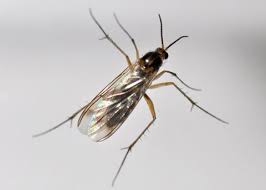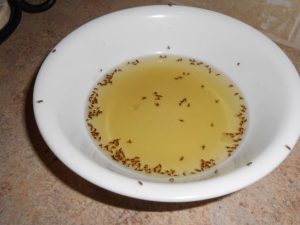What are Gnats?
Gnats are small, winged insects that feed on plants, other insects, or blood. Though appearing to be babies, these tiny pests are full grown adults. Gnats may be biting or non-biting, depending on the species that they are. The lifespan of gnats is fairly short. Eggs hatch within 3 days, and about 4 weeks later the larvae are ready to pupate, which takes about 48 hours. After emerging as an adult, gnats will live anywhere from 5 to 10 days, with the sole purpose of mating to produce more offspring.
 Frequented Areas of Gnats
Frequented Areas of Gnats
Gnats may be found on every continent of the world, even the coldest Arctic and Antarctic regions. Bodies of water and wet soil are the only factors that need to be present for gnats to infest. Anywhere with streams, lakes, and ponds are susceptible to gnats, and the pests may be found indoors or outdoors. If they are indoors, it is likely that they will be dead the next day.
Identification and Physical Characteristics
Normally weak fliers, gnats are small and long legged. Sometimes mistaken for mosquitoes, adult gnats have a back shaped like a hump and are gray, black, or brown in color. The eggs of a gnat are transparent and are laid over water. When traveling in a large group, there may be a loud humming sound heard.
Special Characteristics of Gnats
At dusk, male gnats form a “ghost”, a large mating swarm and eggs may be laid on water or land, depending on the species. The non-biting midges do not possess mouth parts that are capable of biting a human. These types are also drawn to lights and are known to swarm around lights outdoors on summer nights. When laid in water, gnat eggs turn to larvae hatch and drop to the bottom of the water source, feeding on the algae and other organic matter.
Do Gnats Bite?
There are biting and non-biting gnats. However, it is only female gnats that bite. Their aim is to obtain protein which is contained in blood. This protein is used in reproduction.
Gnats have a jagged saw-like mouth which they use to pierce through the skin.
When bitten, you may not know it at the time. But soon, the area may become painful and very itchy. It may also swell and possibly have some blood coming out.
It is recommended that you wash the bitten area with soap and water. Additionally, you can use an ice pack to reduce the pain. It’s also advisable to swab the area with an antiseptic as a gnat bite can carry bacteria.
Types of Gnats
There are many types of gnats. But only a few are common in America.
- Black Gnats
There over 100 species of this type. Although called black gnats, they are dark in color. They have antennae and short legs and the females bite.
- House Plant Gnats
Also called fungus gnats, these are commonly found in plants, mostly those that are overwatered. These gnats eat plant roots and root hairs. They are about 1/8 inch long and the females can lay 300 eggs at once.
- Midges
These resemble mosquitos but do not bite. They are usually yellow, green, or brown in color, measuring 1/8 inch to ¼ inch long. They mostly breed in clogged gutters, ponds, and other dump areas. However, they like to invade houses in large groups as they are attracted to bright lights.
- Drain or sewer flies
These live and breed in drainage systems but they may also be found in organic matter or soil that has been contaminated with sewage. They have hair all over their bodies and are 1/8 inch in length.
Where Gnats Come From
Non-biting gnats are mostly found in freshwater sources and other damp areas while biting gnats love mud or decomposing plants. They enter homes after being attracted by the smell of rotten foods, decomposing pot plants, etc. They can enter through doors, windows, or even small cracks.
Fruit Flies vs. Gnats
Many can’t distinguish fruit flies from gnats, especially when examining them with the naked eye.
Fruit flies are common in summer and fall and are mainly found in kitchens – they like fresh fruits, vegetables, juices, and alcohol. Their bodies, although smaller, are similar to those of house flies. They can be beige or brownish-orange in color.
Gnats, on the other hand, resemble mosquitoes in appearance. Body colors are usually dark, brown, gray, or black. Gnats can be found in different places depending on the species in question. Although they are common inside homes, they are mostly seen outside.
How to Catch Gnats
You can use traps to catch gnats. These traps are easy to create and they make use of tools and products already available in most homes. A good example is the vinegar trap. Here are other methods:
- Jam trap – find a jar of jam that’s about to become empty and add some water in it. Cover the top with a plastic wrap and make small holes on the wrap. The gnats will enter but will be unable to leave.
- Red wine trap – mix red wine with soap and pour the mixture into a jar. Cover the top with a plastic wrap, with the top punctured.
If you do not have red wine, you may as well use rotten food.
What Attract Gnats?
Gnats are mostly attracted to fungus found in homes. The fungus may be present in overripe fruits and vegetables, dirty dishes in the sink, dump areas, or potted house plants.
Removal and Preventative Procedures
To prevent a fungus gnat infestation, identify any plants having wet soil. Let the soil dry out prior to the next watering, this kills the larval stages in the soil. A vacuum cleaner may be used to remove adult gnats from around windows and plants. Also, only watering plans when they need it may help reduce the risk of fungus gnats. Keeping fruit refrigerated will protect it from gnats, as well as prolong the life of the fruit. Removing the food source from gnats is key to preventing an infestation. Though not very efficient, adult gnats may be swatted with a fly swatter.

A gnat trap
Individuals should be sure to get rid of any standing water that is not being used, as this may house gnat eggs.
To make a gnat trap, a jar or can may be used. For instance, if using a mason jar, fill it with apple cider vinegar and then seal it. Poke small holes in the lid with a snail or screw and leave the jar where the gnats are living, normally in a kitchen or dining area. The gnats fly into the jar and will not be able to leave. Once the jar is filled with gnats, it may be disposed of. If apple cider vinegar is not available, regular vinegar will work, though a few drops of dish soap will need to be added. If a jar is not available, a soda bottle can be used. Cut the top 1/3 portion off and place it upside down like a funnel inside of the rest of the bottle, and secure it with tape. A small glass (like a shot glass) ¾ of the way full with red wine and a few drops of dish soap stirred into it. They will land on it and the soap will break the surface tension and the gnats will sink to the bottom.
Application of Chemicals or Electronic Removal
Electric fly exploders electrocute individual gnats and may help control the adult population, but they also may kill beneficial insects. For inside of the home, traps that plug into a wall socket and emit an ultraviolet light attract the gnats and then they are caught in the sticky surface.
These methods are useful for only adult gnats, and to properly treat an infestation a consultation and appointment with a pest control professional will be necessary. They will correctly identify the infestation and utilize the proper chemicals and products to eradicate the problem bugs.
Best Way to Get Rid of Gnats
You should make your home unattractive to gnats. This will ensure that they do not invade it in the first place. The bedrock of a free-gnat home is good sanitation. This should be coupled with other methods of repelling gnats. Here is what you should do:
- Clean dirty dishes immediately.
- Get rid of or cover trash bags around your home.
- Look for and eliminate all damp areas in and around your home. These are usually near drainage systems.
- Change pot soil if it becomes a source of gnats. In addition, do not overwater your potted plants.
- Pour vegetable oil into your sink to bring gnats together. You should then use ammonia to kill them at once.
How to Get Rid of Gnats in Plants
If gnats are coming from potted plants, there are a few measures you can take to get rid of them:
- Remove decaying plants from the pot as they provide a breeding ground for fungus.
- Stop watering the plant until the top 2 inches of soil is dry. This kills larvae and eggs.
- Mix alcohol with water in a 1:2 ratio and pour the mixture into a spray bottle. Spray this on your plants every 3 days.
- Mix liquid dish soap, vinegar, and water. Use this to water your plants.
- Replant your plant with new soil. This should be done when all other methods fail.

No Comments